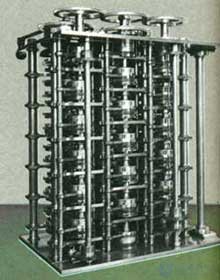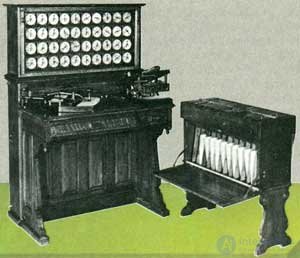Lecture

1822 The difference machine of Charles Babbage was intended for the calculation of mathematical tables.
In 1822, Babbage published a scientific article describing a machine capable of counting and printing large mathematical tables. In the same year, he built a test model of his Difference Machine, consisting of gears and rollers, manually rotated using a special lever. Then, with the support of the Royal Society - the most prestigious scientific organization in the UK - he appealed to the government to finance the creation of a full-scale operating machine. This machine, he wrote to the President of the Royal Society, will undertake “unbearably tedious work”, inevitable with repeatedly repeated mathematical calculations, which “represent the lowest occupation not worthy of human intelligence”. The royal society considered his work "highly worthy of public support," and a year later the British government presented Babbage for the implementation of his project a subsidy of 1,500 pounds. erased
Over the next decade, Babbage tirelessly worked on his invention. Initially, he hoped to complete it in three years, but the Difference Machine became more and more difficult as he modified, refined and redesigned it. Babbage all the time pursued illness, endless work and financial problems. Although the amount of government subsidies eventually rose to 17,000 pounds. Sr., grew and doubts officials of the inexpediency of costs and benefits of the project. In the end, funding was suspended, but only after a few years, the government officially notified Babbage that the allocation of funds for his car was terminated.
1833 G. Babbage was ready to abandon his plans related to the Difference Machine. This is not surprising, if we take into account the complexity of his life. However, continuing to reflect on the same topic, he came to the idea of creating an even more powerful machine. The Babbage analytical machine, unlike its predecessor, had to not only solve mathematical problems of one specific type, but perform various computational operations in accordance with the instructions given by the operator. According to the plan, it was a “machine of the most universal nature” - in fact, it was different as the first universal programmable computer.
The analytical machine had to have such components as a “mill” and a “warehouse” (in modern terminology, an arithmetic unit and memory) consisting of mechanical levers and gears. The memory of the car contained up to 100 forty-digit numbers. These numbers were to be stored in memory until a queue in an arithmetic unit reached them. The result of the operation was either sent to memory in order to also wait for their turn, or they were printed. Instructions, commands, were entered into the Analytical machine using punched cards. “You can rightly say that the Analytical machine weaves algebraic patterns in the same way as the Jacquard loom reproduces flowers and leaves,” wrote Countess Lovelace, one of the few who understood how the machine works and what its potential areas of application are.
Born by Augusta Ada Byron, the only legitimate child of the poet Lord Byron, the Countess gave all of her outstanding mathematical and literary abilities to the Babbage project. Speaking about the Analytical Machine, Babbage noted that the Countess "apparently understands her better than me, and explains her device many, many times better." She perfectly understood the revolutionary essence of the machine - that it really was a “Jacquard mathematical machine”, initially meaningless, but able to execute any program translated into the language of punched cards.
Countess Lovelace helped Babbage clarify his own ideas, inspired him, deeply interested in his work and infecting his enthusiasm. But even her literary gift and charm was not enough to solve the main problem on the path to creating an Analytical machine. If the Difference Machine had dubious chances of success, the Analytical Machine looked unrealistic at all. It was simply impossible to build and launch it. In its final form, the car had to be no less than a railway locomotive. Its internal structure was a random pile of steel, copper and wooden parts, clockwork mechanisms driven by a steam engine. The slightest instability of some tiny detail would lead to a hundredfold increased violations in other parts, and then the whole machine would go berserk.
 |
1834 According to the plan, the Babbage Analytical Machine was supposed to perform various calculations, following a set of instructions. |
The analytical machine was never built. All that has come down to it today is a pile of drawings and drawings, as well as a small part of the arithmetic unit and a printing device designed by Babbage's son.
Ironically, the Difference machine was more fortunate. Although Babbage himself no longer returned to it, the Swedish publisher, inventor and translator Per Georg Schoitz, having read something about this device, built it in a slightly modified version, taking advantage of Babbage's valuable advice. Undoubtedly, it was a joyful and bitter event for Babbage, when he finally saw his (now common) child successfully pass the tests - this happened in 1854 in London. A year later, the Difference Machine Shoytsa was awarded a gold medal at the World Exhibition in Paris. A few years later, the British government, which had refused to support Babbage, had ordered one of these machines for the government office.
Comments
To leave a comment
History of computer technology and IT technology
Terms: History of computer technology and IT technology